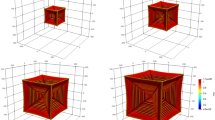Abstract
DIFFaX simulations show that the 3R1 and 3R2 polytypes of hydrotalcites (HT) have distinctly different X-ray powder diffraction (XRPD) patterns. The HT samples obtained by coprecipitation as well as those subjected to a subsequent hydrothermal treatment exhibit non-uniform broadening of lines in their XRPD patterns as well as anomalous variation in the intensities of the basal reflections. The reflections appearing in the mid-2θ region (30–50°; 3–1.8 Å) are excessively broadened and do not correspond to either of the 3R polytypes. This broadening is shown to be due to a stacking of layers randomly rotated about the c crystallographic axis by n × 120° (n = 1,2). The intensities of the basal reflections vary due to the departure of the layer composition from the nominal value, essentially due to an increase in the intercalated water content.
Similar content being viewed by others
References
Artioli, G., Bellotto, M., Gualtieri, A. and Pavese, A. (1995) Nature of structural disorder in natural kaolinites: A new model based on computer simulation of powder diffraction data and electrostatic energy calculation. Clays and Clay Minerals, 43, 438–445.
Bellotto, M., Rebours, B., Clause, O., Lynch, J., Bazin, D. and Elkaim, E. (1996) A reexamination of hydrotalcite crystal chemistry. Journal of Physical Chemistry, 100, 8527–8534.
Bookin, A.S. and Drits, V.A. (1993) Polytype diversity of the hydrotalcite-like minerals I. Possible polytypes and their diffraction features. Clays and Clay Minerals, 41, 551–557.
Bookin, A.S., Cherkashin, V.I. and Drits, V.A. (1993) Polytype diversity of the hydrotalcite-like minerals II. Determination of the polytypes of experimentally studied varieties. Clays and Clay Minerals, 41, 558–564.
Branderburg, K. and Berndt, M. (1996) DIAMOND — Visual Crystal Structure Information System, Version 2.1b. Crystal Impact, Postfach 1251, D-53002 Bonn, Germany. For more information, see https://doi.org/www.crystalimpact.de
Carlino, S. (1997) The intercalation of carboxylic acids into layered double hydroxides: a critical evaluation and review of the different methods. Solid State Ionics, 98, 73–84.
Carrado, K.A., Kostapapas, A. and Suib, S.L. (1988) Layered double hydroxides. Solid State Ionics, 26, 77–86.
Cavani, F., Trifiro, F. and Vaccari, A. (1991) Hydrotalcite-type anionic clays: preparation, properties and applications. Catalysis Today, 11, 173–301.
Constantino, V.R.L. and Pinnavaia, T.J. (1995) Basic properties of Mg2+1−xAl3+x layered double hydroxides intercalated by carbonate, hydroxide, chloride and sulphate anions. Inorganic Chemistry, 34, 883–892.
Dittrich, H. and Wohlfahrt-Mehrens, M. (2001) Stacking fault analysis in layered materials. International Journal of Inorganic Materials, 3, 1137–1142.
Dobos, D. (1975) Solubility products of slightly soluble electrolytes Pp. 221–224 in: Electrochemical Data. A Handbook for Electrochemists in Industry and Universities. Elsevier Scientific Publishing Company, Amsterdam.
Fog, A.M., Freiji, A.J. and Parkinson, G.M. (2002) Synthesis and anion exchange chemistry of rhombohedral Li/Al layered double hydroxides. Chemistry of Materials, 14, 232–234.
Khan, A.I. and O’Hare, D. (2002) Intercalation chemistry of layered double hydroxides: recent developments and applications. Journal of Materials Chemistry, 12, 3191–3198.
Labojos, F.M. and Rives, V. (1996) Thermal evolution of chromium (III) ions in hydrotalcite-like compounds. Inorganic Chemistry, 35, 5313–5318.
Martin, M.J.S., Villa, M.V. and Camazano, M.S. (1999) Glyphosate-hydrotalcite intercalation as influenced by pH. Clays and Clay Minerals, 47, 777–783.
Newman, S.P., Jones, W., O’Connor, P. and Stamires, N. (2001) Synthesis of the 3R2 polytype of a hydrotacite-like mineral. Journal of Materials Chemistry, 12, 153–155.
Oswald, H.R. and Asper, R. (1977) Bivalent metal hydroxides, Pp. 71–140 in: Preparation and Crystal Growth of Materials with Layered Structures, vol. 1 (R.M.A. Lieth, editor). D. Reidel Publishing Company, Dordrecht, The Netherlands.
Ramesh, T.N., Jayashree, R.S. and Kamath, P.V. (2003) Disorder in layered hydroxides: DIFFaX simulation of the X-ray powder diffraction patterns of nickel hydroxide. Clays and Clay Minerals, 51, 570–577.
Reichle, W.T. (1986) Synthesis of anionic clay minerals (mixed metal hydroxides, hydrotalcites). Solid State Ionics, 22, 135–141.
Rousselot, I., Taviot-Guého, C., Leroux, F., Léone, P., Palvadeau, P. and Besse, J.-P. (2002) Insights on the structural chemistry of hydrocalumite and hydrotalcite-like materials: Investigation of the series Ca2M3+(OH)6Cl·2H2O (M3+:Al3+, Ga3+, Fe3+, and Sc3+) by X-ray powder diffraction. Journal of Solid State Chemistry, 167, 137–144.
Seida, Y., Nakano, Y. and Nakamura, Y. (2002) Crystallization of layered double hydroxides by ultrasound and the effect of crystal quality on their surface properties. Clays and Clay Minerals, 50, 525–532.
Taylor, H.F.W. (1973) Crystal structure of some double hydroxide minerals. Mineralogical Magazine, 39, 377–389.
Tichit, D., Rolland, A., Prinetto, F., Fetter, G., de Jesus, M., Martinez-Ortiz, Valenzuela, M.A. and Bosch, P. (2002) Comparison of the structural and acid-base properties of Ga- and Al-containing layered double hydroxides obtained by microwave irradiation and conventional ageing of synthesis gels. Journal of Materials Chemistry, 12, 3832–3838.
Treacy, M.M.J., Deem, M.W. and Newsam, J.M. (2000) Computer code DIFFaX, Version 1.807.
Viani, A., Gualtieri, A.F. and Artioli, G. (2002) The nature of disorder in montmorillonite by simulation of X-ray powder patterns. American Mineralogist, 87, 996–975.
Zhao, Y., Li, F., Zhang, R., Evans, D.G. and Duan, X. (2002) Preparation of layered double-hydroxide nanomaterials with a uniform crystallite size using a new method involving separate nucleation and aging steps. Chemistry of Materials, 14, 4286–4291.
Author information
Authors and Affiliations
Corresponding author
Rights and permissions
About this article
Cite this article
Thomas, G.S., Rajamathi, M. & Kamath, P.V. DIFFaX Simulations of Polytypism and Disorder in Hydrotalcite. Clays Clay Miner. 52, 693–699 (2004). https://doi.org/10.1346/CCMN.2004.0520603
Received:
Revised:
Published:
Issue Date:
DOI: https://doi.org/10.1346/CCMN.2004.0520603




